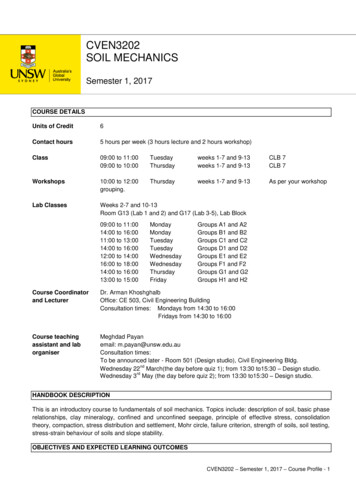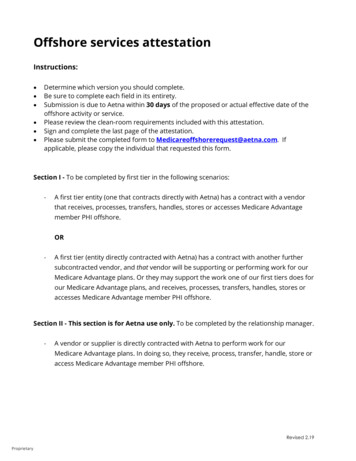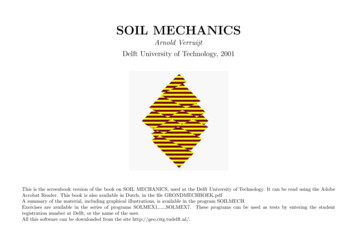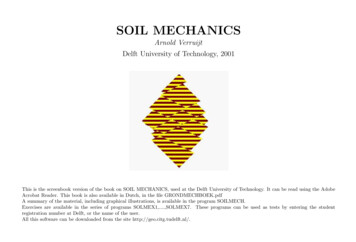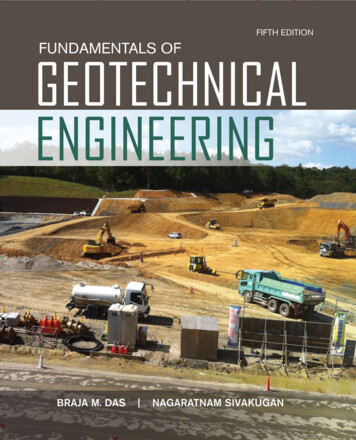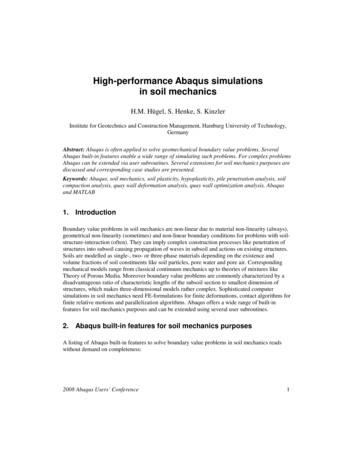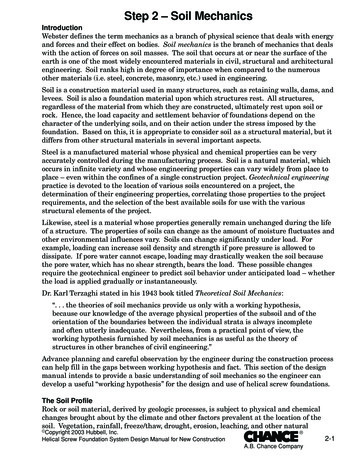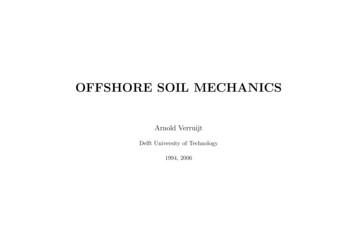
Transcription
OFFSHORE SOIL MECHANICSArnold VerruijtDelft University of Technology1994, 2006
PREFACEThis book was written as class notes for the course on ”Offshore Soil Mechanics” of the Department of Civil Engineering of the Delft Universityof Technology, as given until 2002.In the latest version, which is published on the internet, the format of the pages has been changed to the landscape shape, some figureshave been improved by adding color, and multi-line formulas have been reduced to a single line, profiting from the wider page format. Also twochapters (on consolidation and waves in piles) have been copied from the Soil Dynamics book. Some additional material may be included later.For many problems elementary computer programs are given, in Turbo Pascal. These programs may be used, copied and distributed withoutrestriction. No responsibility for any loss or damage resulting from use of these programs is accepted, however. Some more advanced programscan be downloaded from the author’s website (http://geo.verruijt.net).The notes have been prepared using the LATEX version (Lamport, 1986) of the program TEX (Knuth, 1986). All comments will be highlyappreciated.Delft, January 1994; Papendrecht, March 2006Arnold VerruijtMerwehoofd 13351 NA PapendrechtThe Netherlandstel. 31.78.6154399e-mail : a.verruijt@verruijt.net2
CONTENTS1 Soil Properties . . . . . . . . . . . . . . . . . . . . . . . . . . . . . . . . . . . . . . . . . . . . . . . . . . . . . . . . . . . . . . . . . . . . . . . . . . . . . . . . . . . . . . . . . . . . . . . . . . . . . . . . . . . . . . . . . . . . . . . . 42 Theory of Consolidation . . . . . . . . . . . . . . . . . . . . . . . . . . . . . . . . . . . . . . . . . . . . . . . . . . . . . . . . . . . . . . . . . . . . . . . . . . . . . . . . . . . . . . . . . . . . . . . . . . . . . . . . . . . . . . 103 Sea Bed Response to Cyclic Loads . . . . . . . . . . . . . . . . . . . . . . . . . . . . . . . . . . . . . . . . . . . . . . . . . . . . . . . . . . . . . . . . . . . . . . . . . . . . . . . . . . . . . . . . . . . . . . . . . . . . 314 Cutting Forces in Sand . . . . . . . . . . . . . . . . . . . . . . . . . . . . . . . . . . . . . . . . . . . . . . . . . . . . . . . . . . . . . . . . . . . . . . . . . . . . . . . . . . . . . . . . . . . . . . . . . . . . . . . . . . . . . . . 445 Beams on Elastic Foundation . . . . . . . . . . . . . . . . . . . . . . . . . . . . . . . . . . . . . . . . . . . . . . . . . . . . . . . . . . . . . . . . . . . . . . . . . . . . . . . . . . . . . . . . . . . . . . . . . . . . . . . . . 546 Axially Loaded Piles . . . . . . . . . . . . . . . . . . . . . . . . . . . . . . . . . . . . . . . . . . . . . . . . . . . . . . . . . . . . . . . . . . . . . . . . . . . . . . . . . . . . . . . . . . . . . . . . . . . . . . . . . . . . . . . . . 687 Development of Pile Plug . . . . . . . . . . . . . . . . . . . . . . . . . . . . . . . . . . . . . . . . . . . . . . . . . . . . . . . . . . . . . . . . . . . . . . . . . . . . . . . . . . . . . . . . . . . . . . . . . . . . . . . . . . . . 998 Laterally Loaded Piles . . . . . . . . . . . . . . . . . . . . . . . . . . . . . . . . . . . . . . . . . . . . . . . . . . . . . . . . . . . . . . . . . . . . . . . . . . . . . . . . . . . . . . . . . . . . . . . . . . . . . . . . . . . . . . 1159 Pile in Layered Elastic Material . . . . . . . . . . . . . . . . . . . . . . . . . . . . . . . . . . . . . . . . . . . . . . . . . . . . . . . . . . . . . . . . . . . . . . . . . . . . . . . . . . . . . . . . . . . . . . . . . . . . . 14510 Waves in Piles . . . . . . . . . . . . . . . . . . . . . . . . . . . . . . . . . . . . . . . . . . . . . . . . . . . . . . . . . . . . . . . . . . . . . . . . . . . . . . . . . . . . . . . . . . . . . . . . . . . . . . . . . . . . . . . . . . . . . . . 16411 Gravity Foundations . . . . . . . . . . . . . . . . . . . . . . . . . . . . . . . . . . . . . . . . . . . . . . . . . . . . . . . . . . . . . . . . . . . . . . . . . . . . . . . . . . . . . . . . . . . . . . . . . . . . . . . . . . . . . . . . . 191References . . . . . . . . . . . . . . . . . . . . . . . . . . . . . . . . . . . . . . . . . . . . . . . . . . . . . . . . . . . . . . . . . . . . . . . . . . . . . . . . . . . . . . . . . . . . . . . . . . . . . . . . . . . . . . . . . . . . . . . . . . . . 200Index . . . . . . . . . . . . . . . . . . . . . . . . . . . . . . . . . . . . . . . . . . . . . . . . . . . . . . . . . . . . . . . . . . . . . . . . . . . . . . . . . . . . . . . . . . . . . . . . . . . . . . . . . . . . . . . . . . . . . . . . . . . . . . . . . 2023
Chapter 1SOIL PROPERTIESIn soil mechanics the equilibrium and movement of soil bodies is studied, where soil is understood to be the weathered natural material in theupper layers (say the upper 20 to 100 m) of the earth’s crust. This material may be gravel, sand, clay, peat, or some other rather soft andloose granular medium. The nature of these materials is quite different from artificial man-made materials such as steel, concrete, etc. Thesematerials usually are much more consistent than soils, and exhibit relatively simple, linear, mechanical behaviour, at least if the deformationsare not too large.The mechanical properties of soils are usually strongly non-linear, with the material exhibiting irreversible plastic deformations when loadedand unloaded, even at low stress levels, and often showing anisotropic behaviour, creep and such typical effects as dilatancy (a volume changeduring shear). This mechanical behaviour of soil is also difficult to predict, because the structure of the soil may be highly inhomogeneous,because of its geological history, and it is often not possible to determine the detailed behaviour of the soil by tests in the laboratory or in situ.The behaviour of soils may be further complicated by the presence of water in the pores. This relatively stiff fluid in the pores may prevent orretard volume deformations.For all these reasons the characterization of the mechanical behaviour of soils is often done in a schematic way only, and its form is adapted tothe particular type of problem under consideration. Thus for a problem of long term settlements of an embankment the relevant soil propertiesare quite different from those for a problem of stability of the slopes of the same embankment. Even though these problems may seem to beclosely related, the methods of analysis involve different concepts, and different parameters. In the case of stability of slopes the strength ofthe soil layers is the dominating effect, whereas the settlement of an embankment is mainly governed by the deformation properties of the soil,including creep.Thus in soil mechanics the range of applicability of a certain parameter is often restricted to a limited class of problems. Many propertiescan not be used outside their intended field of application. Nevertheless, various properties may all derive from such common basic phenomenaas interparticle friction, or the structure of a granular medium, so that there may well exist good correlations between certain properties. Inthis chapter some of these properties are reviewed, and some correlations are discussed. It should be noted that in engineering practice nothingcan beat the results of experimental determination of the soil parameters in situ, or in the laboratory. A correlation may at best give a firstestimate of the order of magnitude of a parameter.4
Arnold Verruijt, Offshore Soil Mechanics : 1. SOIL PROPERTIES1.15StiffnessIn many problems of soil-structure interaction the soil is modeled by a subgrade modulus,w p,c(1.1)where w is the settlement of a foundation element, p is the pressure upon it, and c is the subgrade modulus. The soil is modeled by a linearp? - pQQQQQ?wFigure 1.1: Linear spring.spring in this case. One of the main reasons behind the use of this relation may be the simplicity of a linear relationship for analytical ornumerical calculations. It is, of course, a very simplistic way of modeling soil behaviour, and it should be borne in mind that in reality soilsexhibit various forms of non-linear and irreversible behaviour. In some cases it may be justified, however, to use a linear spring model, as a firstapproximation.The flexibility of a plate foundation may be described by considering the soil as a linear elastic continuum, with modulus of elasticity E, and. . . . . . . . . . . . . . . . . . . . . .Figure 1.2: Foundation on elastic soil.Poisson’s ration ν. For a rigid circular plate the following relation between pressure and settlement may be derived, on the basis of Boussinesq’s
Arnold Verruijt, Offshore Soil Mechanics : 1. SOIL PROPERTIES6elementary solution for a point load on an elastic half plane (Timoshenko & Goodier, 1951),π(1 ν 2 ) p D,4Ew (1.2)where D is the diameter of the plate. A linear relationship between the load p and the displacement w is obtained, which is of course aconsequence of the assumption that the soil behaves as a linear elastic material.It is interesting to note that a similar relation can be obtained by starting from the assumption that in the soil the stresses are distributedhomogeneously over an area of gradually increasing magnitude, over an angle of say 45 with the vertical direction, see figure 1.3. This means. . . . . . . . . . . . . . . . . . . . . . . . . . . . . . . . . . . . . . . . . . . . . . . .Figure 1.3: Foundation on elastic soil, approximation.that at a depth z below the surface the area carrying the load isA 14 π(D 2z)2 .(1.3)The vertical normal stress at that depth is the total force F 14 πD2 p, divided by the area A,p.(1 2z/D)2(1.4)p.E(1 2z/D)2(1.5)σv If the medium is assumed to be elastic, the strain at this depth isεv Because εv dw/dz, where w is the vertical displacement, one now obtains, after integration from z 0 to z ,w pD.2E(1.6)
Arnold Verruijt, Offshore Soil Mechanics : 1. SOIL PROPERTIES7Comparison of eq. (1.6) with eq. (1.2) shows that these two formulas are of the same nature. The only difference is the magnitude of thenumerical coefficient. In general one may writepD,(1.7)w αEwhere magnitude of the coefficient α is between 1 and 2.Comparison of eq. (1.7) with eq. (1.1) shows that the elastic subgrade model is in agreement with the elastic continuum model ifc αE.D(1.8)It appears that a larger plate has a smaller average stiffness. This can be understood intuitively by noting that the soil surrounding the area ofa plate is partly being taken down by the plate, so that only a small amount of additional stress is needed to displace a larger plate.The modulus of elasticity of a soil may be correlated with the compressibility constant C in Terzaghi’s logarithmic formulaε 1σlog( ),Cσo(1.9)where σo is the initial stress, and σ is the actual stress, σ σo σ. If the stress increment σ is small one may write,ε 1 σ σlog(1 ) .CσoC σo(1.10)If this is compared with the elastic relation ε σ/E it follows thatE C σo .(1.11)This means that the stiffness of the soil increases linearly with the stress level, or with the depth below the soil surface. Such an increase instiffness is indeed often observed in engineering practice, although the increase is often not so strong as the linear relation (1.11) suggests. Therelation can be used to estimate the the modulus of elasticity of a soil, if the compressibility C and the stress level σo are known. Commonvalues are C 100 to C 500 for sand, and values in the range from C 20 to C 100 for clay. The precise value for a certain soil can easilybe determined in the laboratory in an unconfined compression test (oedometer test), at least in principle. It must be noted that the values givenabove apply to virgin loading of a soil, under relatively large deformations. When unloading a soil, or reloading it below the maximum stressever reached before, the soil is much stiffer, say by a factor 10. Thus in the case of very small deformations a soil may be much stiffer than inthe case of large deformations beyond the pre-consolidation stress level.It is sometimes considered too complicated to take a sample, determine its compressibility in the laboratory, and then use this value tocalculate the appropriate stiffness for the structure. This procedure requires a very careful handling of the soil sample, during sampl
the soil layers is the dominating effect, whereas the settlement of an embankment is mainly governed by the deformation properties of the soil, including creep. Thus in soil mechanics the range of applicability of a certain para

